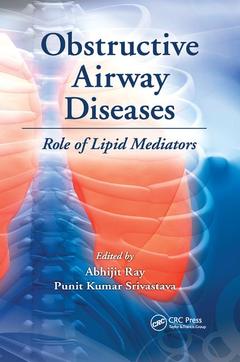Description
Obstructive Airway Diseases
Role of Lipid Mediators
Coordinators: Ray Abhijit, Srivastava Punit Kumar
Language: English
Subjects for Obstructive Airway Diseases:
Keywords
LTC4 Synthase; TH2 Cell; lipid biology; Cytosolic Phospholipase A2; drug discovery and design; Airway Hyperresponsiveness; obstructive airway diswase; LTA4 Hydrolase; airway inflammation; COPD Patient; asthma and COPD; Severe Asthma; ASM Cell; FLAP Inhibitors; Receptor Antagonist; PLA2 Enzyme; Exercise Induced Asthma; HASMCs; Lipid Mediators; LPA Receptor; CysLT Receptor; S1P Receptor; LPA Level; Leukotriene Receptor Antagonists; LXA4; Inhaled Corticosteroid; sEH Inhibitors; LPA; PKC Isoforms
Publication date: 09-2018
· 15.6x23.4 cm · Paperback
Publication date: 11-2011
382 p. · 15.6x23.4 cm · Hardback
Description
/li>Contents
/li>Readership
/li>Biography
/li>
Incidences of inflammatory airway diseases are on the rise across the world. Existing therapeutic options are ineffective, unsafe, and expensive, and severe cases are nonresponsive to conventional therapy. Therefore, it is imperative that research be undertaken to discover new treatment options. Obstructive Airway Diseases: Role of Lipid Mediators discusses clinically successful and potential lipid targets that can make a difference in treating some of the most intractable disease states.
Topics discussed include:
- Obstructive airway diseases, etiology, pathophysiology, and existing therapeutic options
- What constitutes a lipid and how it is broken down to generate biologically active mediators
- The role of enzymes in the process of lipid mediator synthesis
- The biology of arachidonic acid, platelet-activating factor, and lysophosphatidic acid and the role they play in airway inflammation
- Products of arachidonic acid metabolism such as leukotrienes, prostaglandins, epieicosatrienoic acid, and oxoeicosatetraenoic acid
- Proresolution lipid mediators in inflammatory airway disease conditions
- The role of sphingosine and ceramide in inflammatory airway disease
- Protein kinases activated by lipid mediators and those that trigger the generation of lipid messengers
The combined input of a panel of international authorities on lipid mediators makes this volume a valuable resource for all those involved in researching, teaching, and studying airway inflammation as well as those involved in drug discovery research.
Punit Srivastava maintains a blog with additional information about the book and his work.
Obstructive Airway Diseases: Epidemiology, Etiology, and Therapeutic Options. Lipids: Reservoir of Drug Targets. Phospholipase A2 as a Potential Drug Target for Airway Disorders. 5-Lipoxygenase Pathway: A Validated Route to Drug Discovery. Leukotriene Receptor Antagonists and FLAP Inhibitors. EETs and Oxo-ETE in Airway Diseases. The Eosinophil Chemoattractant 5-Oxo-ET. Cyclooxygenases and Prostaglandin Receptors. Proresolution Mediators of Inflammation in Airway Diseases: Resolvins Pave New Directions. Platelet-Activating Factor Antagonist Therapy for Airway Disorders. Lysophosphatidic Acid in Airway Inflammation. Sphingolipids in Airway Inflammation. Protein Kinase C Isozymes and Airway Inflammation. Prospects for PI3 Kinase Signaling Inhibition in Obstructive Airway Diseases. Index.
Abhijit Ray has worked in human trials with molecules designed to treat airway inflammation associated with asthma and COPD and has published more than 60 articles in peer-reviewed journals. He has been the senior director and head of biology research at Daiichi Sankyo Life Science Research Centre India, Gurgaon since July 2010. As a member of the drug discovery team, he manages a group of 60 scientists engaged in discovery research for drugs in the areas of infectious and inflammatory diseases.
Punit Srivastava has been a group leader of biology at Daiichi Sankyo Life Science Research Centre India, Gurgaon since July 2010. He was a member of the drug discovery group of Ranbaxy Laboratories Ltd. from 2004 to June 2010 and has worked for more than six years in drug discovery research, which has resulted in one molecule entering human trial for COPD. He has published more than 15 articles in peer-reviewed journals and filed at least six patents. As a member of the drug discovery team at Daiichi Sankyo, he is leading projects in the area of inflammation.
These books may interest you

Heterogeneity in Asthma 158.24 €



